This article may contain affiliate links. Please see our affiliate disclaimer in the footer menu for more information. Thank you for your support!
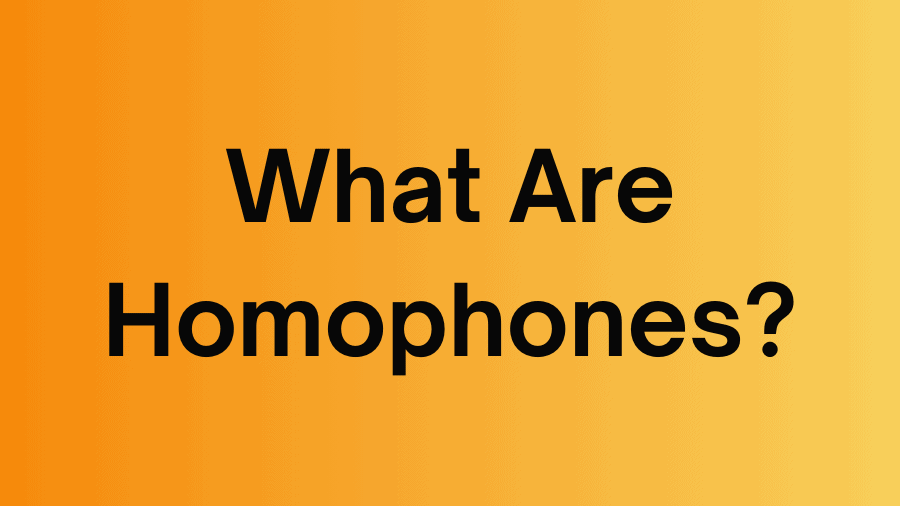
The English language is full of homophones. And although homophones make English more interesting and alluring, they confuse even native English speakers.
Mistakes with common homophones are surprisingly easy to make. As a proofreader, I check for errors with both challenging homophones and simple ones.
Let’s explore homophones by learning what they are and seeing some common examples.
What Are Homophones?
Homophones are words that sound the same but have different meanings and usually different spellings.
The word homophone comes from the Greek words homos, meaning same, and phōnē, meaning sound (source).
People often use the words their, there, and they’re as an example of homophones. These words are a practical example since we encounter each of them regularly.
I wish I could say I’ve never made a mistake with this trio of homophones, but that would be far from the truth—I’ve mixed up these words on multiple occasions.
The strange thing about homophones is that we manage to mix them up—even though we’re aware of the differences between them.
What’s the Difference between Homophones and Homographs?
Homophones are words that are pronounced the same way but differ in meaning or spelling. For example, the words to, too, and two are homophones because they sound the same, but each has a separate meaning.
Homographs are words with the same spelling but different meanings.
Some think these words must also be pronounced differently to qualify as homographs.
Close and close are homographs.
The word close can mean nearby; it can also mean to shut.
I authored an article called “50+ Sentences with Homographs (Definitions Included)” if you’d like to learn more about this subject.
What Are Homonyms?
Homonyms are words that are homophones, homographs, or both.
Therefore, homonyms are words that have the same pronunciation (spelling unimportant), the same spelling (pronunciation unimportant), or both.
Nonetheless, a stricter definition of homonyms requires words to be homophones and homographs simultaneously (source). Thus, words would need to have the same pronunciation and spelling to be considered homonyms.
Since homonyms are defined in multiple ways, it’s no wonder we get confused about them.
How to Remember Homophones vs. Homographs vs. Homonyms
How can we remember the difference between these three h words? We can focus on the endings of the first two words—phone and graph.
When we talk on the phone, we hear sound coming through. Thus, homophones are words that sound the same.
And we use pencils made of graphite to write (or spell) words. So homographs are words that are spelled the same.
Fun Fact: The core of pencils isn’t made of lead; it’s made mainly of graphite.
Then, we’re left with the troublesome term: homonyms. As mentioned, homonyms are either homophones or homographs, or both.
Now let’s hone our homophonic know-how by getting a handle on 35 basic homophones!
Examples of Homophones
The homophones below are listed in alphabetical order.
Many of the homophones in this article have more than one meaning. For example, the word right can mean correct; it can also mean the opposite of left when speaking about directions.
However, to keep things simple, I’ve assigned only one meaning to each word I discuss.
1) Ate vs. Eight
Ate: the past tense of the verb eat, meaning to consume food
Amanda ate an apple for an afternoon snack.
Eight: the number after seven
Spiders have eight legs.
Memory tip: You can rearrange the letters in the word ate to spell eat.
2) Bare vs. Bear
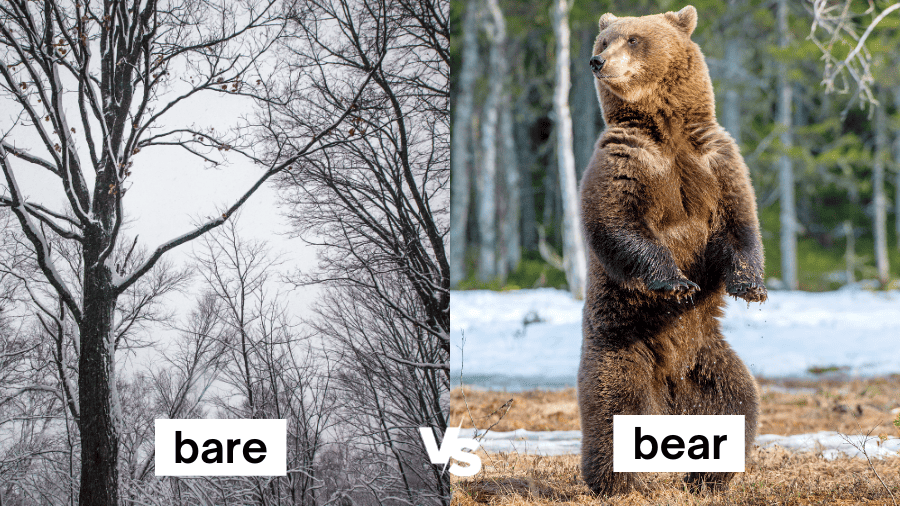
Bare: something that has nothing in it or on it, empty
Many trees are bare in winter because they’ve lost their leaves.
Bear: a big, furry animal
What would you do if you saw a bear in the woods?
3) Be vs. Bee
Be: to exist, to live
Many people are familiar with Shakespeare’s quote “To be, or not to be: that is the question.”
Bee: an insect that makes a buzzing sound
The bee went from flower to flower to collect pollen.
4) Blew vs. Blue
Blew: the past tense of blow, meaning to push air out of your mouth
He blew out all eight candles on his birthday cake.
Blue: one of the three primary colors
If you mix blue and yellow, you get green.
5) Brake vs. Break
Brake: a device used for slowing or stopping
If you want your car to move forward, you need to take your foot off the brake.
Break: to cause something to split into pieces
If you drop a wine glass, it may break.
6) Buy vs. By vs. Bye
Buy: to purchase, to exchange money for a product or service
Joe is going to buy his son a football.
By: a preposition, sometimes meaning near
Taylor loves to sit by the river.
Bye: short for goodbye
He said bye to her as she walked out the door.
7) Chews vs. Choose
Chews: plural form of chew, meaning to break down food with our teeth before swallowing it
Sally politely chews with her mouth closed.
Choose: to pick, to select
You can choose which game we play next.
8) Coarse vs. Course
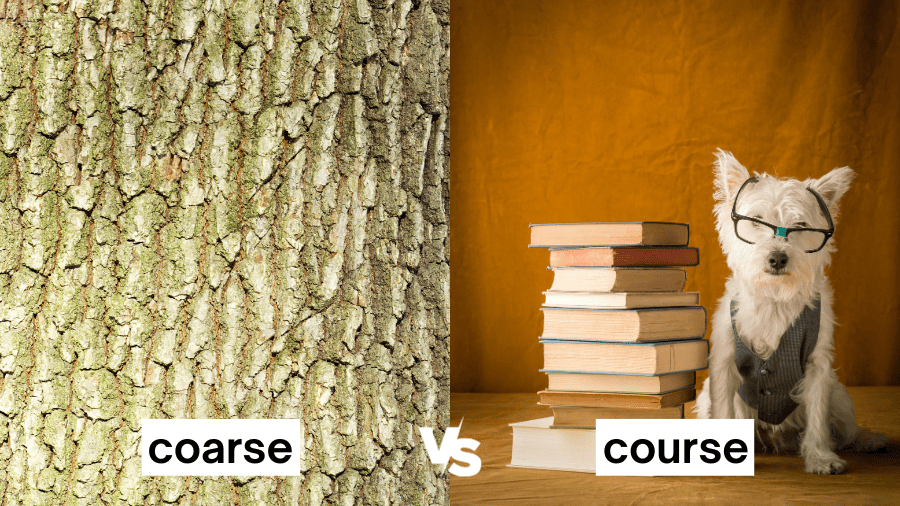
Coarse: a rough texture
Sandpaper has a coarse surface.
Course: a class
Devon wants to take a course in personal finance.
9) Dear vs. Deer
Dear: of high value, loved
I’ve known my dear friend Sydney for almost forty years. (It’s true!)
Deer: a graceful animal that lives in the forest
I saw a beautiful deer when I was walking through the woods.
10) Do vs. Due
Do: to perform an action
She is going to do some exercise now.
Due: expected or required at a specific time
Vanessa’s rent payment is due on the first day of each month.
11) Eye vs. I
Eye: what we use to see with
The dog has one blue eye and one brown eye.
I: a singular, first-person subjective pronoun
I love to do crossword puzzles!
12) Flour vs. Flower
Flour: a powdery ingredient that is commonly used in baking
The recipe calls for two cups of flour.
Flower: the (usually) colorful part of a plant that blooms
The boy picked a flower for his sister to cheer her up.
13) For vs. Four
For: a preposition (it sometimes tells us who is supposed to receive something)
This gift is for you.
Four: the number after three
A square has four corners.
Memory Tip: There are four letters in the word four, but only three in for.
Note: There are also four letters in the word fore, but this word isn’t nearly as common as four.
14) Hair vs. Hare
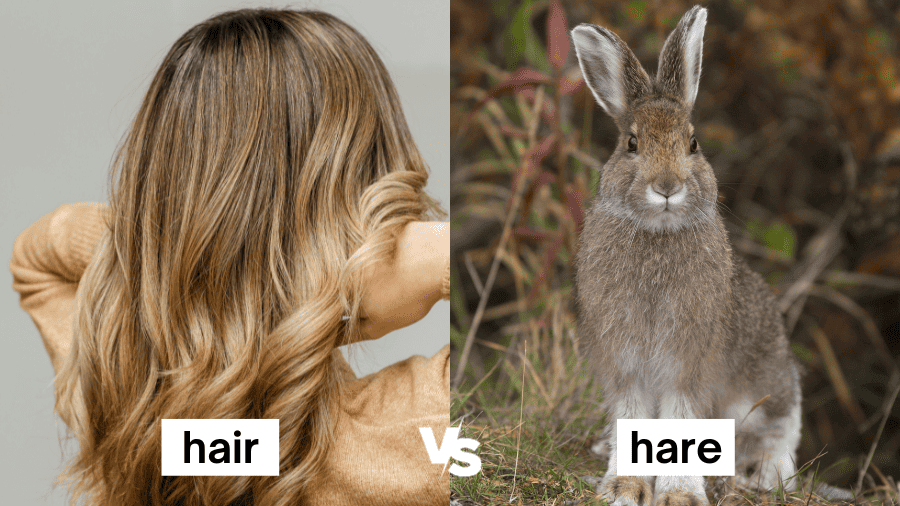
Hair: the strands that grow on our head
The little girl wants to have long hair like her mother.
Hare: an animal that’s like a rabbit
I hope to see a hare when I’m in the field.
Memory Tip: We talk about hair blowing in the wind or breeze. If you think about hair blowing in the air, it can help you remember the difference between these two terms.
15) Heal vs. Heel
Heal: to cure
Some people say that holding your breath helps to heal a case of hiccups.
Heel: the back part of your foot
If you have a narrow heel, it may slip out of a shoe.
16) Hear vs. Here
Hear: to perceive sound with our ears
Mary loves to hear the birds chirping.
Here: a place close by
You can keep your collection of seashells right here.
Memory Tip: The last three letters of the word hear spell ear.
17) Hole vs. Whole
Hole: an opening in something, an empty space
You need to dig a little hole in the ground to plant a seed.
Whole: a complete unit
If one piece is missing, you no longer have a whole puzzle.
18) Hour vs. Our
Hour: sixty minutes
They’re going to take a one-hour walk in the afternoon.
Our: a plural, first-person possessive pronoun
We think our dog is the cutest pup on the planet!
19) It’s vs. Its
It’s: a contraction of it is (or it has)
It’s time to smell the roses.
Its: a singular, third-person possessive pronoun
The butterfly emerged from its cocoon.
20) Know vs. No
Know: to have knowledge of
We know how powerful kindness can be. 😊
No: the opposite of yes
No, I don’t want to watch paint dry for the next seven hours!
21) One vs. Won
One: a single unit
You can choose one piece of candy from the basket.
Won: the past tense of win, meaning to come in first place in a game or competition
Ayan won the game because he scored the most points.
22) Pair vs. Pear
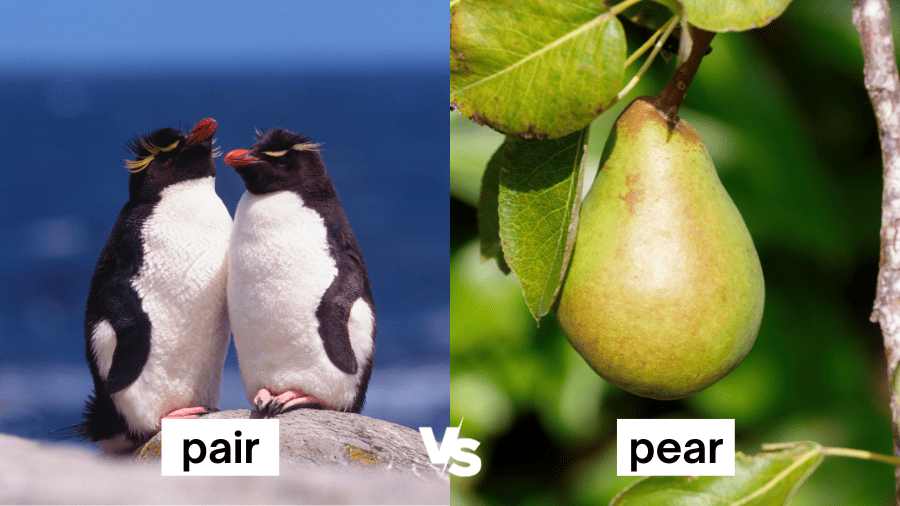
Pair: a set of two
Have you ever lost one sock that belongs to a pair?
Pear: a sweet fruit
A ripe, juicy pear is one of his favorite foods.
23) Peace vs. Piece
Peace: calm, tranquility
The mother took a bath so she could have some peace and quiet.
Piece: a part of something
The child gave a piece of his candy bar to a friend.
24) Right vs. Write
Right: correct
If you tell me one plus one equals four, I’ll tell you that’s not right.
Write: to form words on a screen or piece of paper
I like to write articles for my website.
25) Role vs. Roll
Role: a person’s duty or job
The main role of teachers is to educate their students.
Roll: to move by turning repeatedly (like the way a wheel moves)
If you roll the beach ball to me, I’ll roll it back to you!
26) Sea vs. See
Sea: the ocean
Have you ever gone swimming in the sea?
See: using our eyes to look at things
Do you see the ladybug on that flower?
27) Sole vs. Soul
Sole: the bottom part of the foot
She’s ticklish on the sole of her foot.
Soul: the essence or spirit of who we are
What a kind person with a beautiful soul!
28) Stair vs. Stare
Stair: a step (usually part of a series of steps)
The cat likes to sleep on the first stair of the staircase.
Stare: to keep looking directly at someone or something
If you stare at someone, it will probably make them uncomfortable.
29) Tail vs. Tale
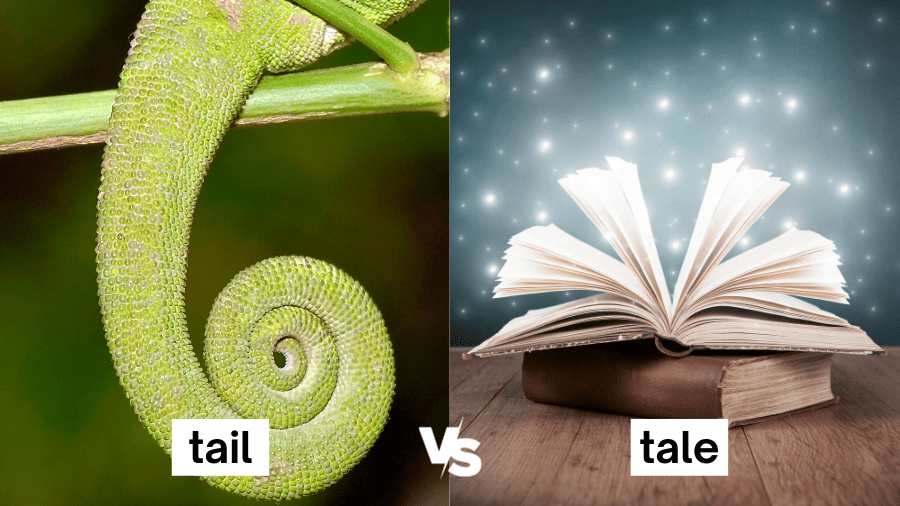
Tail: the part at the back of some animals
The dog wagged his tail because he was happy.
Tale: a story (usually make-believe)
A Tale of Two Cities is a well-known novel.
30) Their vs. There vs. They’re
Their: a plural, third-person possessive pronoun
Our neighbors love to plant vegetables in their garden.
There: refers to a place that’s not close to the speaker
We will call you when we get there.
They’re: a contraction of they are
Do you think they’re going to the picnic?
31) To vs. Too vs. Two
To: the first part of the infinitive form of a verb (e.g., to run, to jump, to fly)
Robin loves to hike in the mountains.
Too: also
I want to go bowling too!
Two: the number after one
One plus one equals two.
32) Waist vs. Waste
Waist: the part of your body around your stomach (where you’d wear a belt)
The man wore a brown belt around his waist.
Waste: not making good use of something
Buying a toy car for Bobby was a waste of money because he never played with it.
33) Wear vs. Where
Wear: to have on your body (clothes, jewelry, shoes, etc.)
Jenny wants to wear her favorite shirt to school today.
Where: the location of something
Do you know where I put my keys?
Memory Tip: The word here is found within the word where. Both where and here have to do with location.
34) Which vs. Witch
Which: a question word involving a choice of something from a specific set of things
Which book do you want to read first?
Witch: a character from stories who can perform magic
I remember dressing up as a witch for Halloween one year.
35) You’re vs. Your
You’re: a contraction of you are
You’re such a rock star! (Yes, I’m talking to you! 😊)
Your: a second-person possessive pronoun (can be singular or plural)
It’s your turn to go first.
Frequently Asked Questions

Why do I need to understand homophones?
You need to understand homophones because they’re an important part of the English language. Knowing the correct homophone to use in a given context helps you communicate effectively.
When you choose the wrong term, people will stumble over your sentence and may not know what you mean.
And even if the reader knows what you meant to say, a homophonic error will lessen the readability of your writing due to it being unclear.
What are some tips for remembering homophones?
Some tips for remembering homophones include the following:
1) Use the memory tips in this article, and create your own.
Don’t worry about how silly your memory strategy may sound. Sometimes, the best memory tips are the weird ones that require you to use your imagination.
2) Make flashcards for homophones.

You can start with the ones in this article. Write a homophone on one side of the flashcard and the definition on the other. You’ll be well on your way to mastering basic homophones just by designing your own set of flashcards.
Although you can make flashcards on a computer, I suggest you use three-by-five index cards and write everything by hand. The process of writing will help you remember them.
3) Read as much as possible.
Read anything that interests you (e.g., books, magazines, blog posts, comics). You’ll continually encounter common homophones no matter what you read.
Seeing them in the right context will help you make sense of them. Whenever you come across a new one, add it to your set of flashcards.
4) Proofread your writing for homophonic errors.
To become a homophone hero, you want to be mindful of the ones you use in your writing. Checking for the misuse of homophones will ensure you don’t reinforce bad habits.
Plus, any writing you do will help strengthen your knowledge of these similar-sounding words!
5) Take homophone quizzes.
Quizzes are a fun and effective way to see what you’ve mastered and what you still need to practice. Conveniently, a quiz is waiting for you below. 😉
When you’re ready for more of a challenge, check out the first quiz in this article containing proofreading tests. It’s a quiz that only tests one’s understanding of homophones.
Quiz: Homophones
Ready to start the homophone quiz? Let’s due do it!
Important: After completing the quiz, you’ll need to scroll up the page to click the “View score” button.
I hope this article has helped you become more confident using common homophones!
Homophones are an essential part of English grammar, but they require a focus on spelling. I wrote an article about the differences between spelling and grammar if you’d like to check it out.
Best wishes to you!
“I’m not defined by my flaws or mistakes. I’m focusing on radical self-compassion, giving myself the grace I freely give others.”
-S.M. Klees
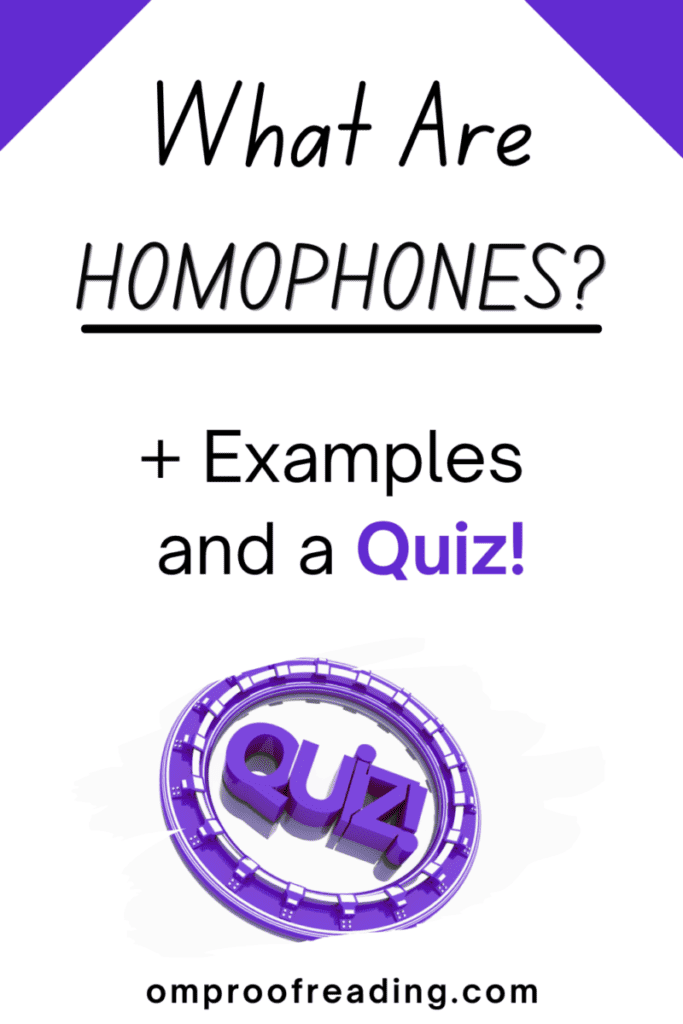
Recent Posts
Punctuation is important because it enables us to communicate our message clearly and effectively. Without punctuation, we wouldn’t understand how units of a sentence relate to one another or how...
Although you're probably somewhat familiar with adverbs, you may be unaware of sentence adverbs. As a trained proofreader who has studied the parts of speech, I can help you understand this unique...
